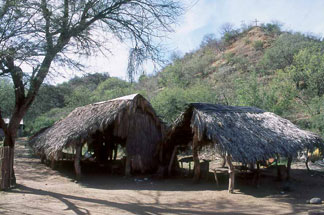About the Reserve
 The dramatic landscape of the Northern Jaguar Reserve is one of the last truly wild refuges for the jaguar. Deep canyons descend from upland peaks and mountain valleys. Sheer cliffs and volcanic rock outcrops soar above. Perennial streams abound, and water seems plentiful as summer rainstorms create spectacular waterfalls that trickle down steep mountain drainages and travel toward the free-flowing Río Aros.
The dramatic landscape of the Northern Jaguar Reserve is one of the last truly wild refuges for the jaguar. Deep canyons descend from upland peaks and mountain valleys. Sheer cliffs and volcanic rock outcrops soar above. Perennial streams abound, and water seems plentiful as summer rainstorms create spectacular waterfalls that trickle down steep mountain drainages and travel toward the free-flowing Río Aros.
Part of the basin-and-range geological province, the majority of the reserve is situated along the backbone of the Sierra Zetasora, a small foothills range with elevations up to 4,000 feet. The vegetation is as varied as the topography: well-preserved oak forests mix with native fan palms; lone palm trees that might be expected along the canyon bottoms sit perched on the tops of small mountains; and the vast slopes and hills are covered with dense thornscrub that transitions into sub-tropical vegetation.
The main access is by four-wheel drive vehicle along a single-track dirt road that dead-ends upon reaching the reserve. This infrequently used road is extremely rugged and often in disrepair; it regularly gets washed away during the rainy season, and in some places it barely passes for a road no matter the time of year, having been compared to an equestrian trail. The bad road was the best filter to help keep people out and wildlife unharmed in the decades before this land was protected.

There are several sections of the reserve that correspond with their former ranch divisions. At the reserve’s entrance is La Ventana, which acts as the reserve headquarters in a mesquite-filled valley with a small shaded creek that has year-round flow. The ranch house is situated directly beneath an immense series of rock monoliths that form la ventana, or the “window to the sierra.” Next are Babisal de Arriba and Babisal de Abajo, considered by many to be the ecological heart of the reserve due to their rich biological diversity and pristine nature. Babisal de Arriba sits at the confluence of two deep and lush canyons featuring a perennial stream lined with towering sycamore trees. The third section is Dubaral, with easy access to the Río Aros and the site of many recent jaguar photographs and the video of a mating pair. At the end of the road is Los Pavos; this ranch was the first property purchased in 2003, so it has had more time for the vegetation to recover since cattle removal and it most resembles true wilderness. Other areas include Carricito, Tésotas, and Bábaco, which have had extensive jaguar sightings in recent years, including females and their cubs.

